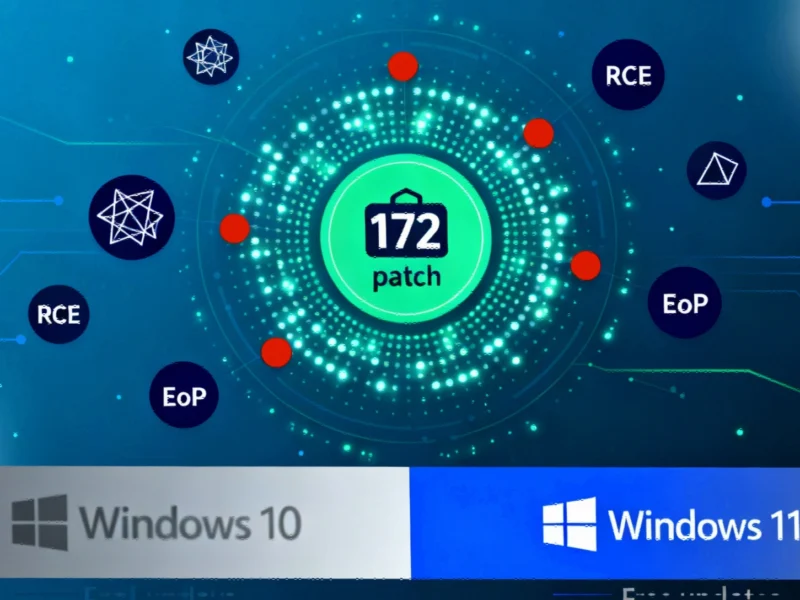Massive Patch Tuesday Deployment
Microsoft has unleashed its October 2025 Patch Tuesday security updates, delivering fixes for an unprecedented 172 security vulnerabilities across its product ecosystem. This comprehensive security overhaul addresses six zero-day vulnerabilities actively being exploited in the wild, marking one of the most significant security deployments in recent months. The timing coincides with major industry shifts across the technology landscape, including Intel’s latest Linux kernel optimizations that are reshaping enterprise computing infrastructure.
Among the patched vulnerabilities, eight carry the “Critical” severity rating, including five remote code execution flaws and three elevation of privilege issues. The breakdown reveals 80 elevation of privilege vulnerabilities, 31 remote code execution flaws, 28 information disclosure issues, 11 security feature bypasses, 11 denial of service vulnerabilities, and 10 spoofing vulnerabilities. This security push comes as Microsoft navigates complex global technology challenges similar to those facing other major tech corporations operating in international markets.
Zero-Day Vulnerabilities Neutralized
Microsoft addressed six zero-day vulnerabilities, including two publicly disclosed flaws in Windows SMB Server and Microsoft SQL Server, plus three actively exploited vulnerabilities. The company’s proactive approach to these threats demonstrates its commitment to enterprise security, particularly as Microsoft addresses 172 security vulnerabilities that could potentially impact millions of systems worldwide.
CVE-2025-24990 represents a critical elevation of privilege vulnerability in the Windows Agere Modem Driver. Microsoft took the unprecedented step of completely removing the vulnerable driver (ltmdm64.sys) that allowed attackers to gain administrative privileges. “Microsoft is aware of vulnerabilities in the third party Agere Modem driver that ships natively with supported Windows operating systems,” the company stated, noting that removing the driver would disable related Fax modem hardware.
Another significant zero-day, CVE-2025-59230, affected Windows Remote Access Connection Manager, enabling attackers to gain SYSTEM privileges. Microsoft explained that exploitation required “some measurable amount of effort,” but the vulnerability nonetheless posed serious risks to enterprise environments.
Secure Boot and Processor-Level Threats
The patches extend beyond traditional Windows vulnerabilities to include system-level threats. CVE-2025-47827 addressed a Secure Boot bypass affecting IGEL OS, where the igel-flash-driver module improperly verified cryptographic signatures, allowing attackers to mount crafted root filesystems from unverified images.
Perhaps most concerning was CVE-2025-0033, affecting AMD EPYC processors using Secure Encrypted Virtualization – Secure Nested Paging (SEV-SNP). This race condition during Reverse Map Table initialization could allow compromised hypervisors to modify RMP entries before locking. While not exposing plaintext data, the vulnerability could significantly impact memory integrity in cloud environments. Microsoft noted that fixes for Azure Confidential Computing clusters remain in progress.
Windows 10 Support Sunset and Enterprise Implications
This Patch Tuesday marks the end of an era, representing the final free security updates for Windows 10. Organizations now face critical decisions about their upgrade paths, with Extended Security Updates (ESU) available for purchase—one year for consumers and up to three years for enterprises. This transition period coincides with other significant technological advancements across the industry that are reshaping how companies approach digital transformation.
The security landscape continues to evolve rapidly, with Microsoft’s massive patch deployment occurring alongside groundbreaking scientific discoveries that could influence future security methodologies and major strategic moves in the cryptocurrency exchange sector that highlight the increasing importance of robust security frameworks.
Industry-Wide Security Implications
Microsoft’s comprehensive security update underscores the escalating challenges facing enterprise security teams. The inclusion of vulnerabilities affecting hardware-level components like TPM 2.0 (CVE-2025-2884) demonstrates how security threats now span the entire technology stack. This reality is further emphasized by recent disturbing revelations about massive data exposures affecting organizations worldwide.
Security professionals must prioritize deploying these patches immediately, particularly for the Critical-rated remote code execution vulnerabilities that could enable attackers to take complete control of affected systems. The coordinated disclosure and patch development process involving multiple external researchers and internal Microsoft teams highlights the collaborative nature of modern cybersecurity defense.
As organizations worldwide implement these critical updates, the technology community continues to witness unprecedented security challenges that demand increasingly sophisticated responses from both vendors and enterprise security teams. Microsoft’s October 2025 Patch Tuesday represents a crucial milestone in this ongoing battle against evolving cyber threats.
Based on reporting by {‘uri’: ‘techrepublic.com’, ‘dataType’: ‘news’, ‘title’: ‘TechRepublic’, ‘description’: ‘Providing IT professionals with a unique blend of original content, peer-to-peer advice from the largest community of IT leaders on the Web.’, ‘location’: {‘type’: ‘country’, ‘geoNamesId’: ‘6252001’, ‘label’: {‘eng’: ‘United States’}, ‘population’: 310232863, ‘lat’: 39.76, ‘long’: -98.5, ‘area’: 9629091, ‘continent’: ‘Noth America’}, ‘locationValidated’: False, ‘ranking’: {‘importanceRank’: 199473, ‘alexaGlobalRank’: 3969, ‘alexaCountryRank’: 2546}}. This article aggregates information from publicly available sources. All trademarks and copyrights belong to their respective owners.



